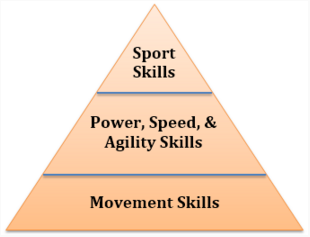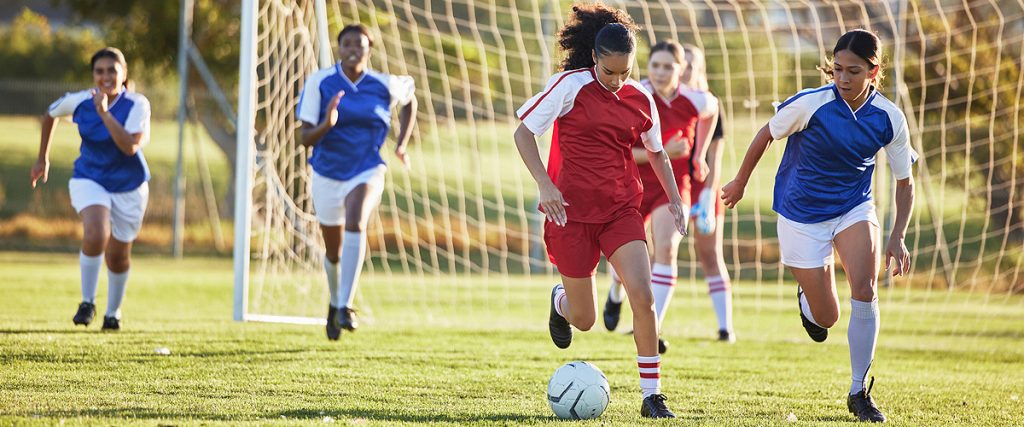As their 13-year-old daughters played in their first soccer game of the spring season, the mothers discussed their dedication to their children, and their children’s dedication to the game. One mother spoke about her older daughter, a high-school sophomore, who missed the fall soccer season because of knee surgery. This caught my attention, and I scanned the field: Four of the 22 players – 12 and 13 years old – on the field wore bulky knee braces indicative of some form of injury.
Another mother mentioned the ankle injuries of an older sibling, and a father mentioned the concussions. Each parent appeared to try and top the others with stories of their children’s injuries and surgeries from their participation in soccer, as though being injured and returning to continue one’s career was a badge of honor. The players who were revered were not the ones who capably moved around the field, avoiding tackles, and skillfully playing the ball, but the ones who limped around the field, showing their toughness as they returned to soccer from an injury, probably far too quickly.
Rene Wormhoudt, the strength and conditioning coach for the Netherlands Football Federation, said at the Seattle Sounders Sports Science Conference that children become good movers, good movers become good athletes, and good athletes become specialists, or skilled soccer players. These u14 girls appeared to have skipped the first two steps and moved directly toward the goal of becoming a skilled soccer player.

The skill level was impressive for an early season game between 12 and 13 year olds. The players used tactics and skills that I never learned or tried in my 10 years of youth soccer. Players played the ball back to the goalie to avoid pressure rather than panicking with the ball in their defensive third. Goalies controlled the ball and juked on-rushing attackers rather than kicking the ball as quickly and as far as possible. Players used one-twos all over the field, and played the ball with their right and left feet. They kept their shape, talked to each other on the field, and showed a good understanding of the game.
Despite their game understanding and technical skills, the majority were terrible soccer players. Their skills were no match for the few athletic players on the field. The vast majority of players moved so poorly that the mere act of playing soccer was likely a risk to their health. The injuries discussed by the parents were no surprise after watching 20 minutes of their younger daughters.
Despite their sport-specific skills, they lacked good motor control. When they jumped to head or chest the ball, their arms flailed wildly. When they ran shoulder to shoulder with an opponent, one of the players inevitably went tumbling, unable to absorb any contact. When players landed from jumps, without jumping very high, their knees caved in (knee valgus), a common precursor to ACL ruptures. They struggled to decelerate or change directions to avoid collisions, and many fouls were symptoms of poor movement skills and body control.
Rather than becoming good movers initially and progressing to sport-specific skills, these players appeared to strive for soccer success. These teams dutifully performed the FIFA11+ warmup (below), designed to reduce injuries by teaching and training basic movements, but there was no concentration or corrections on the warmup. The coach set up the next drill as the players performed their warmup, and the players quickly moved through the exercises in order to get to the important drills, the ones with the ball. The warmups with the ball were primarily linear; they dribbled in a straight line and passed to another player, or they dribbled at the goal and took a shot. Very few of the movements in warmups engaged the players or challenged their movement skills.
Despite their soccer success, these girls were not good athletes. Based on the conversations of the parents, most played year-round soccer rather than compete in another sport. The year-round play may have helped with the early mastery of their sport-specific skills, but none of the girls had a long future in the sport unless they greatly enhanced their athleticism and movement skills.
In all likelihood, more of those 22 players will miss a season in their four years of high school due to an injury suffered while playing soccer than will extend their soccer career beyond high school. Adolescent females who specialized in one sport were 1.5 times as likely as those who participated in multiple sports to suffer from patellofemoral pain (PFP; Hall et al., 2014), and girls’ soccer has the highest rate of ACL injuries, with 11.7 injuries for every 100,000 athlete exposures (an athlete exposure is one athlete participating in one practice or competition; Comstock et al., 2013). Furthermore, youth soccer players who practiced four or more days per week prior to age 12, as did some of these girls based on the sideline conversations, were more likely to suffer cam deformities to their hip than those who waited until after age 12 to practice four or more days per week (Tak et al., 2015).
Rather than focus on more soccer and continuing to expand their soccer skills, these players would be served better by playing another sport, especially track and field. University of North Carolina head coach Anson Dorrance has said that he prefers to recruit sprinters because of the added speed on the field. These players are working backwards, as they originally skipped the correct progression of mover to athlete to player. Now, they must try to work backward from player to athlete to mover, and running track and field, and especially the sprints, would be one approach to learn better movement skills. Additionally, the players should concentrate in their movement warmup and expand upon this brief warmup with additional plyometics and strength exercises. Before trying to add another layer of skill, or another step-over dribbling move, they should master running, jumping, landing, and stopping.
When I was a child, playing and training was less sophisticated than it is for the current generation. However, in our sophistication, we have ignored the basic progressions. When I was a child, we played in the streets and at recess before we joined teams. We played tag, hopscotch, and other childhood games. From an adult training perspective, these games appear frivolous; however, this progression enabled us to learn basic movement skills first. When we joined teams, we had a better base of fundamental movement skills that we developed through these playful games. When children skip this natural learning and jump straight into sophisticated, sport-specific training schemes, they miss these learning opportunities. They may master technical skills or game awareness, but without the basic movement skills and athleticism, their performance eventually will stagnate because other children – often the multi-sport athletes or the late developers – move better and are more athletic. Sport-specific skill is important; however, the proper progression of mover to athlete to skill enables the greatest expression of the sport-specific skill in adolescence and beyond.
Originally published in Los Angeles Sports & Fitness Magazine October 2015 By Brian McCormick, PhD

